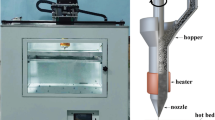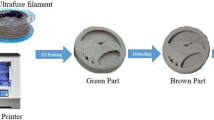Abstract
3D printing has the unique advantages of personalized customization and machining of pure metal parts. However, high equipment cost of laser 3D printing to prepare pure metal parts has limited the wide application of metal 3D printing. Combination of material extrusion (MEX) with debinding and sintering leads to a low-cost process of creating solid metal parts. In this study, filament filled with 316 L stainless steel (316LSS) powder at 91 wt% is used to fabricate full metal parts. The 3D printing, debinding, and sintering process are thoroughly investigated, and the parameters are optimized with respect to the properties of the part. A two-step debinding process is performed especially to obtain full metal parts. Cyclohexane debinding is optimized to create an interconnected network to ensure the full release of the binder. Thermal-debinding process is optimized based on thermogravimetric analysis. Physicochemical characterization of the parts is then performed. After processing, parts show the highest density, microhardness, and tensile strength of 94.23%, 131.36 HV, and 343 MPa, which are comparable to the average level of previous reports. The reported process technique in this study opens the way to create intricate-shaped 316LSS parts for complex bionic structures, functional integration, lightweight, shape cooling, prototype spare parts, and biological implants, making it a new choice to manufacture metal parts for engineering applications.













Similar content being viewed by others
References
Liu R, Wang Z, Sparks T, Liou F, Newkirk J (2017) Aerospace applications of laser additive manufacturing. In: Brandt M (ed) Laser additive manufacturing. Woodhead Publishing, London, pp 351–371
Huang R, Riddle M, Graziano D, Warren J, Das S, Nimbalkar S, Cresko J, Masanet E (2016) Energy and emissions saving potential of additive manufacturing: the case of lightweight aircraft components. J Clean Prod 135:1559–1570
Juechter V, Franke MM, Merenda T, Stich A, Körner C, Singer RF (2018) Additive manufacturing of Ti-45Al-4Nb-C by selective electron beam melting for automotive applications. Addit Manuf 22:118–126
Fu K, Yao Y, Dai J, Hu L (2017) Progress in 3D printing of carbon materials for energy-related applications. Adv Mater 29(9):1603486
Tofail SAM, Koumoulos EP, Bandyopadhyay A, Bose S, Donoghue LO, Charitidis C (2018) Additive manufacturing: scientific and technological challenges, market uptake and opportunities. Mater Today 21(1):22–37
Montani M, Demir AG, Mostaed E, Vedani M, Previtali B (2017) Processability of pure Zn and pure Fe by SLM for biodegradable metallic implant manufacturing. Rapid Prototyping J 23(3):514–523
Chen F, Wang Q, Zhang C, Huang Z, Jia M, Shen Q (2022) Microstructures and mechanical behaviors of additive manufactured Inconel 625 alloys via selective laser melting and laser engineered net shaping. J Alloy Compd 917:165572
Li Y, Kan W, Zhang Y, Li M, Liang X, Yu Y, Lin F (2021) Microstructure, mechanical properties and strengthening mechanisms of IN738LC alloy produced by Electron Beam Selective Melting. Addit Manuf 47:102371
Hryha E, Riabov D (2022) Metal powder production for additive manufacturing. In: Caballero FG (ed) encyclopedia of materials: metals and allloys. Elsevier, Oxford, pp 264–271
Gong G, Ye J, Chi Y, Zhao Z, Wang Z, Xia G, Du X, Tian H, Yu H, Chen C (2021) Research status of laser additive manufacturing for metal: a review. J Market Res 15:855–884
Blakey-Milner B, Gradl P, Snedden G, Brooks M, Pitot J, Lopez E, Leary M, Berto F, du Plessis A (2021) Metal additive manufacturing in aerospace: a review. Mater Design 209:110008
Langlais D, Demers V, Brailovski V (2022) Rheology of dry powders and metal injection molding feedstocks formulated on their base. Powder Technol 396:13–26
Cao D, Malakooti S, Kulkarni VN, Ren Y, Lu H (2021) Nanoindentation measurement of core–skin interphase viscoelastic properties in a sandwich glass composite. Mech Time-Depend Mat 25(3):353–363
Shad A, Stache R, Rütjes A (2021) Effects of fumed silica flow aids on flowability and packing of metal powders used in Binder-Jetting additive manufacturing process. Mater Design 212:110253
Cao D, Malakooti S, Kulkarni VN, Ren Y, Liu Y, Nie X, Qian D, Griffith DT, Lu H (2022) The effect of resin uptake on the flexural properties of compression molded sandwich composites. Wind Energy 25(1):71–93
Jiang D, Ning F (2021) Additive manufacturing of 316L stainless steel by a printing-debinding-sintering method: effects of microstructure on fatigue property. J Manuf Sci E-T Asme 143(9):1–30
Singh G, Missiaen J, Bouvard D, Chaix J (2021) Additive manufacturing of 17–4 PH steel using metal injection molding feedstock: analysis of 3D extrusion printing, debinding and sintering. Addit Manuf 47:102287
Palmero EM, Casaleiz D, de Vicente J, Hernández-Vicen J, López-Vidal S, Ramiro E, Bollero A (2019) Composites based on metallic particles and tuned filling factor for 3D-printing by fused deposition modeling Composites. Part A Appl Sci Manuf 124:105497
Singh S, Singh G, Prakash C, Ramakrishna S (2020) Current status and future directions of fused filament fabrication. J Manuf Process 55:288–306
Das S, Das S (2021) Properties for polymer, metal and ceramic based composite materials, In Brabazon (ed) Encyclopedia of materials: composites. Elsevier: Oxford, pp 815–821
Gonzalez-Gutierrez J, Arbeiter F, Schlauf T, Kukla C, Holzer C (2019) Tensile properties of sintered 17–4PH stainless steel fabricated by material extrusion additive manufacturing. Mater Lett 248:165–168
Singh G, Missiaen J, Bouvard D, Chaix J (2021) Additive manufacturing of 17–4 PH steel using metal injection molding feedstock: analysis of 3D extrusion printing, debinding and sintering. Addit Manuf 47:102287
Thompson Y, Gonzalez-Gutierrez J, Kukla C, Felfer P (2019) Fused filament fabrication, debinding and sintering as a low cost additive manufacturing method of 316L stainless steel. Addit Manuf 30:100861
Wagner MA, Hadian A, Sebastian T, Clemens F, Schweizer T, Rodriguez-Arbaizar M, Carreño-Morelli E, Spolenak R (2022) Fused filament fabrication of stainless steel structures - from binder development to sintered properties. Addit Manuf 49:102472
Bobbio LD, Bocklund B, Simsek E, Ott RT, Kramer MJ, Liu Z, Beese AM (2022) Design of an additively manufactured functionally graded material of 316 stainless steel and Ti-6Al-4V with Ni-20Cr, Cr, and V intermediate compositions. Addit Manuf 51:102649
Singh G, Pandey PM (2019) Rapid manufacturing of copper components using 3D printing and ultrasonic assisted pressureless sintering: experimental investigations and process optimization. J Manuf Process 43:253–269
Sharafi S, Santare MH, Gerdes J, Advani SG (2021) A review of factors that influence the fracture toughness of extrusion-based additively manufactured polymer and polymer composites. Addit Manuf 38:101830
Ngo TD, Kashani A, Imbalzano G, Nguyen KTQ, Hui D (2018) Additive manufacturing (3D printing): a review of materials, methods, applications and challenges. Compos B Eng 143:172–196
Safka J, Ackermann M, Machacek J, Seidl M, Vele F, Truxova V (2020) Fabrication rocess and basic material properties of the basf Ultrafuse 316Lx material. Mm Sci J 2020:4216–4222
Krug S, Zachmann S (2009) Influence of sintering conditions and furnace technology on chemical and mechanical properties of injection moulded 316L. Powder Inject Mould Int 3(4):66–70
Raza MR, Ahmad F, Omar MA, German RM, Muhsan AS (2013) Role of debinding to control mechanical properties of powder injection molded 316L stainless steel. Advanced Materials Research 699:875–882
Liu B, Wang Y, Lin Z, Zhang T (2020) Creating metal parts by fused deposition modeling and sintering. Mater Lett 263:127252
Mäkikangas J, Rautio T, Mustakangas A, Mäntyjärvi K (2019) Laser welding of AlSi10Mg aluminium-based alloy produced by selective laser melting (SLM). Procedia Manufacturing 36:88–94
Ni C, Shi Y, Liu J (2018) Effects of inclination angle on surface roughness and corrosion properties of selective laser melted 316L stainless steel. Mater Res Express 6:036505
Fathi P, Rafieazad M, Duan X, Mohammadi M, Nasiri AM (2019) On microstructure and corrosion behaviour of AlSi10Mg alloy with low surface roughness fabricated by direct metal laser sintering. Corros Sci 157:126–145
Fathi P, Mohammadi M, Duan X, Nasiri AM (2019) Effects of surface finishing procedures on corrosion behavior of DMLS-AlSi10Mg_200C alloy versus die-cast A360.1 aluminum. Jom-Us 71(5):1748–1759
Cano S, Gonzalez-Gutierrez J, Sapkota J, Spoerk M, Arbeiter F, Schuschnigg S, Holzer C, Kukla C (2019) Additive manufacturing of zirconia parts by fused filament fabrication and solvent debinding: selection of binder formulation. Addit Manuf 26:117–128
Li Y, Liu S, Qu X, Huang B (2003) Thermal debinding processing of 316L stainless steel powder injection molding compacts. J Mater Process Tech 137(1):65–69
Choi J, Lee G, Song J, Lee W, Lee J (2015) Sintering behavior of 316L stainless steel micro–nanopowder compact fabricated by powder injection molding. Powder Technol 279:196–202
Hwang KS, Tsou TH (1992) Thermal debinding of powder injection molded parts: observations and mechanisms. Metall Trans A 23(10):2775–2782
Raza MR, Ahmad F, Muhamad N, Sulong AB, Omar MA, Akhtar MN, Aslam M, Sherazi I (2017) Effects of debinding and sintering atmosphere on properties and corrosion resistance of powder injection molded 316 L - stainless steel. Sains Malays 46(02):285–293
Shengjie Y, Lam YC, Yu SCM, Tam KC (2002) Thermal debinding modeling of mass transport and deformation in powder-injection molding compact. Metall and Mater Trans B 33(3):477–488
German RM (1987) Theory of thermal debinding. International Journal of Powder Metallurgy 23:237–245
Sadaf M, Bragaglia M, Nanni F (2021) A simple route for additive manufacturing of 316L stainless steel via fused filament fabrication. J Manuf Process 67:141–150
Tascioglu E, Karabulut Y, Kaynak Y (2020) Influence of heat treatment temperature on the microstructural, mechanical, and wear behavior of 316L stainless steel fabricated by laser powder bed additive manufacturing. Int J Adv Manuf Technol 107(5):1947–1956
Gong H, Snelling D, Kardel K, Carrano A (2019) Comparison of stainless steel 316L parts made by FDM- and SLM-based additive manufacturing processes. Jom-Us 71(3):880–885
Zhang Y, Feng E, Mo W, Lv Y, Ma R, Ye S, Wang X, Yu P (2018) On the microstructures and fatigue behaviors of 316L stainless steel metal injection molded with gas- and water-atomized powders. Metals-Basel 8(11):893
Röttger A, Boes J, Theisen W, Thiele M, Esen C, Edelmann A, Hellmann R (2020) Microstructure and mechanical properties of 316L austenitic stainless steel processed by different SLM devices. Int J Adv Manuf Technol 108(3):769–783
Ji S, Gu Q, Xia B (2006) Porosity dependence of mechanical properties of solid materials. J Mater Sci 41(6):1757–1768
Kokubo T, Kim H, Kawashita M (2003) Novel bioactive materials with different mechanical properties. Biomaterials 24(13):2161–2175
Prajitno D, Maulana A, Syarif D (2016) Effect of surface roughness on contact angle measurement of nanofluid on surface of stainless steel 304 by sessile drop method. J Phys: Conf Ser 739:012029
Vautrin-Ul C, Taleb A, Stafiej J, Chaussé A, Badiali JP (2007) Reprint of “Mesoscopic modelling of corrosion phenomena: coupling between electrochemical and mechanical processes, analysis of the deviation from the Faraday law.” Electrochim Acta 52(27):7802–7810
Burstein GT, Pistorius PC (1995) Surface roughness and the metastable pitting of stainless steel in chloride solutions. Corrosion-Us 51(5):380–385
Galvele JR (2005) Tafel’s law in pitting corrosion and crevice corrosion susceptibility. Corros Sci 47(12):3053–3067
Melia MA, Duran JG, Koepke JR, Saiz DJ, Jared BH, Schindelholz EJ (2020) How build angle and post-processing impact roughness and corrosion of additively manufactured 316L stainless steel. Npj Mat Degrad 4:21
Dwivedi D, Lepková K, Becker T (2017) Carbon steel corrosion: a review of key surface properties and characterization methods. Rsc Adv 7(8):4580–4610
Funding
This study was financially supported by the National Natural Science Foundation of China (NSFC) [Grant Nos. 52175374, 51805014, and 51905531].
Author information
Authors and Affiliations
Contributions
Chengyu Zhang: conceptualization, methodology, software, formal analysis, writing—original draft; Yanping Yuan: data curation, writing—original draft, funding acquisition; Chengkun Shi: visualization, investigation; Jimin Chen: resources, supervision.
Corresponding authors
Ethics declarations
Competing interests
The authors declare no competing interests.
Additional information
Publisher's Note
Springer Nature remains neutral with regard to jurisdictional claims in published maps and institutional affiliations.
Rights and permissions
Springer Nature or its licensor (e.g. a society or other partner) holds exclusive rights to this article under a publishing agreement with the author(s) or other rightsholder(s); author self-archiving of the accepted manuscript version of this article is solely governed by the terms of such publishing agreement and applicable law.
About this article
Cite this article
Zhang, C., Yuan, Y., Shi, C. et al. Material extrusion-based fabrication of 316L stainless steel: analysis of debinding and sintering, mechanical properties, and corrosion resistance. Int J Adv Manuf Technol 129, 587–599 (2023). https://doi.org/10.1007/s00170-023-12309-w
Received:
Accepted:
Published:
Issue Date:
DOI: https://doi.org/10.1007/s00170-023-12309-w




